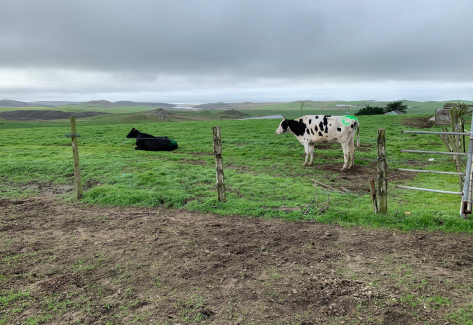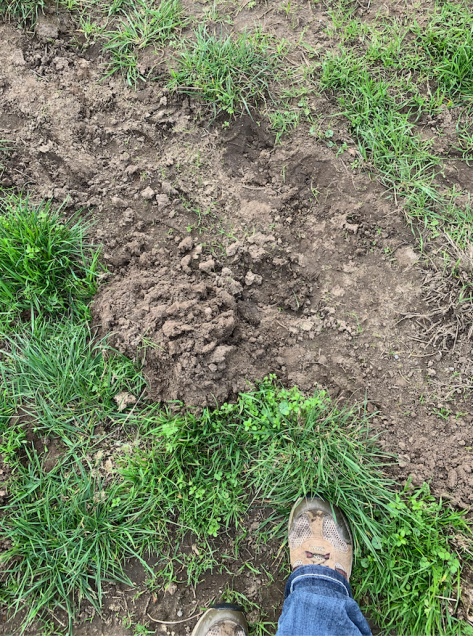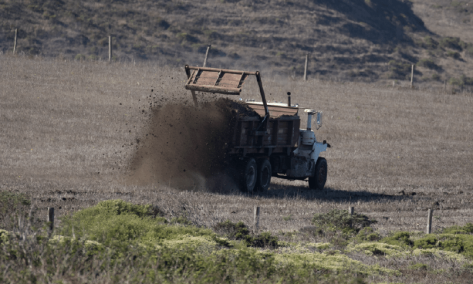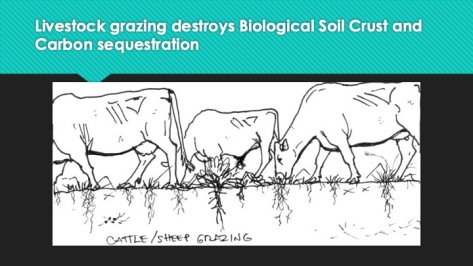
The former lush bunchgrass prairies along the Pacific coastal mountains in central California, once home to herds of tule elk, wide-roaming grizzlies, and salmon-filled streams, carefully managed for thousands of years by Miwok and many other tribes, are now mostly grazed instead by herds of cattle. Mediterranean weeds cover the grazed pastures where coastal prairies once grew. Most of the central Coast Range mountains are in private hands and inaccessible to the public. Point Reyes National Seashore is a rare public park established to restore and protect these California plant and animal species and habitats.
But the recent Point Reyes National Seashore planning process for how the park will manage the public lands here for the next 30 years has been controversial. I want to shed light on the science that backs up a widespread and popular push to eventually retire cattle grazing on the Seashore and fully restore these amazing lands to nature and accessible public recreation. Just 28,000 acres of public lands among hundreds of thousands of acres of private lands gazed by beef and dairy cattle in Marin and Sonoma Counties.
I’ve been giving a lot of Zoom panels on various topics, such as the growing grassroots movement to end commercial beef and dairy ranching at Point Reyes National Seashore. Thank you Diane Elise Gentile and John Crowley for organizing these.
This post expands on part of my 10-minute Zoom presentation, as I received many inquiries by viewers wishing to know more, and wanting to study the information at their leisure. As a wildlife biologist and plant ecologist at Western Watersheds Project, and researcher of deep time holding a degree in Paleontology from the University of California at Berkeley, I have been fascinated by biological soil crusts lately–some types of which are among the most ancient life forms known from the fossil record.
The issue of cattle impacts to the integrity of California native coastal prairies has come up a lot recently, and relates to how plant communities are managed by public agencies across the West from the sagebrush-steppe to the Mojave Desert. Specifically here, I have focused on the impacts domestic livestock have on the delicate micro-ecology of biological soil crusts of the coastal prairie, and the ripple effect livestock overgrazing has on weed increase, soil health, and carbon sequestration at Point Reyes National Seashore.
What are Biological Soil Crusts?
Biological soil crusts are a complex of mosses, fungi, lichens, green algae, cyanobacteria, and liverworts that form a tiny carpet of growth on many soils even in grasslands and deserts, with roots, filaments, and living networks growing deep into the soil. These various organisms create a living soil that sequesters carbon, helps plants grow, and holds the soil together to stop erosion, and absorb water. Many organisms that make up these living soils are actually integral to all life on Earth.

These are life forms we usually do not think about, as they are very small and easily missed on the landscape. But they are abundant in healthy soils, and contribute to the stability and biodiversity of the plant communities we see and visit. What follows are photos I have taken of ungrazed grasslands and deserts where biological soil crusts are an integral part of the ecosystems, and show what original healthy plant communities should look like when not degraded.
- Liverworts and mosses are ancient non-vascular plants, with no true leaves, and no xylem and phloem (the tissues able to transport water and nutrients in vascular plants that form grasses, shrubs, and trees). They reproduce by spores instead of seeds, and need a thin film of water for the spores to be fertilized and spread. Even a rare desert rainstorm can accomplish this.



- Fungi are a completely different kingdom of life, separate from plants and animals and forming their own unique lineage of biodiversity. Most vascular plants could not grow without the remarkable symbiotic fungi, with their extensive mycorrhizae (Greek: “fungus roots”) that break down raw rock, connect with plant roots and supply essential nutrients. The fine, extensive network of hyphae (branching filaments of the mycorrhizal network) collect water and minerals not available to plant roots, and by connecting symbiotically with plant roots are available to provide vascular plants with these micronutrients. In exchange, the fungal network receives carbohydrate and sugar “food” made by photosynthesis in the plant leaves. The absence of mycorrhizal fungi can slow plant growth on degraded landscapes. Mushrooms are the fruiting bodies of this complex and intricate web of fungal filament networks that are usually hidden from view under the soil surface.


- Green algae are photosynthetic eukaryotic (advanced cells with a nucleus and organelles) organisms that may group together to form such diverse life forms as seaweed, giant kelp, and filamentous soil green algae that are part of biological soil crusts in many cases. (All plants, fungi, and animals–including humans–are made up of eukaryotic cells.)


- Blue-green “algae” in many biological soil crusts are actually a form of photosynthetic cyanobacteria, not algae and not even plants. They are simple prokaryotic cells that lack a nucleus and organelles. Cyanobacteria may be the most amazing components of biological soil crusts of all, being the oldest fossils ever found–dating back to 3.5 billion years ago. Single-celled cyanobacteria can form visible colonies in biotic soils. But in the early history of life on Earth, some cyanobacteria may have symbiotically entered eukaryotic cells to form chloroplasts–the cellular organ that makes energy for plants by photosynthesis. In other words, every plant now contains a cyanobacterium in each cell that is an integral part of plants as we know them. There would be no plants without cyanobacteria. This theory of endosymbiosis (microbes helping each other) was pioneered by evolutionary biologist Lynn Margulis. Even more, the early atmosphere of Earth billions of years ago that allowed life to flourish, was produced by ancient aquatic cyanobacteria breathing in carbon dioxide and exhaling out oxygen in huge amounts from the oceans. This created the atmosphere as we now know it. There would be no flourishing life on land and sea without cyanobacteria. And, as biologists Sasha Reed, Manuel Delgado-Baquerizo, and Scott Ferrenberg describe, “Cyanobacteria are an interesting focus not only because of their ubiquity, importance in ecosystem function, and potential responsiveness to global change, but also because of their role in one of the most transformative events in the Earth’s history: the transition of photosynthetic life from aquatic environments to land.” Biocrusts containing cyanobacteria have been found in the fossil record dating to around 2.6 billion years ago as early terrestrial mats, long before the first land plants appeared. These are truly remarkable micro-organisms inhabiting the intact coastal prairies of Point Reyes National Seashore.

- Lichens are actually two organisms living as one symbiotically: filaments of fungus plus algae or cyanobacteria. The fungus provides the protective body, and the algae and cyanobacteria provide the green pigment chlorophyll, enabling them to use the sunlight’s energy to make their own food from water and carbon dioxide through photosynthesis. They also provide vitamins to the fungus. Lichens cling to trees, to rocks, and to soils. An extremely important function of lichens is that they provide a mode of survival in harsh, arid environments where algae and cyanobacteria cannot normally survive. Since the fungus can protect its algae and bacteria, these normally water-requiring organisms can live in dry, sunny climates such as grasslands without dying, as long as there are occasional rain showers or flooding to let them recharge and store food for the next drought period. Because lichens enable algae to live all over the world in many different climates, they also provide a means to convert carbon dioxide in the atmosphere through photosynthesis into oxygen, which we all need to survive. At Point Reyes National Seashore, the fog-drip creates mini cloud-forests of fruticose lichens growing under a few inches tall in ungrazed coastal prairie remnants.


Other names for biological soil crusts are biocrusts, cryptobiotic crusts, and cryptogamic soil crusts (“crypto” because these life forms are hidden and mysterious). They are “living soils,” full of threads and networks of filaments that connect with plant roots in complex and symbiotic ways. Deep-rooted native bunchgrasses may have roots going down 6 feet into the prairie soil, and biological soil crusts connect with these roots, aiding the bunchgrasses to acquire water during dry seasons, plus extract the maximum amount of nutrients from soils.
Biological soil crusts can cover soils, tree branches, and even bare rock–extracting minerals and nutrients from these substrates, and with rainwater or fog, powered by sunlight, fixing carbon and nitrogen from the atmosphere to produce living communities on a micro-scale that we usually are not aware of. As we shall see, these micro-ecosystems under our feet have a profound impact on carbon cycling and climate change. But commercial agricultural practices and development can degrade and eliminate these living soils and their Carbon-storing ability.
Cattle Impacts to Delicate Soil Crusts



Over the last several months I’ve been getting a lot of questions from the concerned public about livestock grazing impacts to native grasslands, and how cattle and domestic sheep impact the native plant communities that we value. I’ve been leading field trips to show people what ungrazed native perennial grasslands look like, and how this compares to degraded cattle pastures that are so rampant across California and the western U.S.
Observation is so important, and I was happily surprised to discover several remnant ungrazed or lightly-elk-grazed native grasslands at Point Reyes National Seashore that represent what most of the West looked like, say 500 years ago, before the onslaught of cattle and sheep converted these grasslands to weed fields.
Seeing is believing. When you see an ungrazed native grassland with intact biological soil crust, which is very rare now in its’ original form, you begin to piece together the history of how these native plant communities, symbiotic with non-vascular plants and fungi, have been severely impacted and destroyed over the past few hundred years–and ongoing–by commercial livestock operations. I think most agency staff have no idea what a truly native, healthy, functioning grassland looks like (as it would have appeared 1,000 years ago with elk, antelope, deer, and ground squirrel grazing).
During these field observations I discovered beautiful examples of intact native grasslands and deserts, and what struck me over and over again, was the biological soil crusts. These are like miniature rain forests on a micro-scale, soaking up fog, dew and rain. The biocrusts then go dormant during the dry season, and perhaps for years waiting for moist rainy conditions during droughts.
Biological soil crusts are very important components of native healthy grasslands–they sequester carbon, they hold the soil surface together in a thick spongy network that absorbs rainwater, they defends against erosion, and they keep invasive weeds (like annual brome grasses) from gaining a foothold. When you find a biocrust and walk on it, it is like walking on a sponge.
Biological soil crusts create living soils, with filaments reaching deep down into the soil profile. I have become increasingly aware of these micro-communities across many bioregions, from the rainy coasts to the arid deserts and sagebrush steppes.
I have also seen the progression of destruction of these original native perennial bunchgrasslands with symbiotic biological soil crusts that reach deep into the soil, with heavy cattle and sheep grazing converting these native plant communities into Eurasian annual grasslands, with shallow roots, and destroyed biological soil crust.
The trampling and grazing of native grasslands and biological soil crusts by concentrated herds of cattle fenced into pastures will destroy the above-ground plants and mosses, fungi, and lichens. This eventually kills off the root reserves and interconnected mycorrhizae and biological soil crust filament network.
The result of heavy livestock grazing is inevitably dead soils. No deep roots, no hyphae, no mycorrhizae. Barbed-wire fences that section off grasslands into smaller trampled areas, water troughs that pipe water to cattle away from natural water sources, year-long cattle grazing that beats down the delicate lichen, moss, and living crust soil structures, killing off the deep-soil network, will degrade native grasslands.

Elk Versus Cattle
While walking around a rare remnant coastal prairie at Point Reyes National Seashore where cattle do not access, I found instructive signs of the native tule elk to compare with the ubiquitous cattle-grazed pastures. The elk’s light hoof tracks in the spongy grass and mossy ground, a few small droppings contrasted sharply with the adjacent cattle-grazed pastures where bare ground, mud, masses of “cow pies” and large hoof tracks trample the ground.
I could find no biological soil crusts in these cattle pastures, only shallow-rooted European annual grasses such as hare barley (Hordeum murinum), soft chess (Bromus hordeaceus), and ripgut brome (B. daindrus). Invasive weeds such as poison hemlock (Conium maculatum) and milk thistle (Silybum marianum) were also prevalent.




The Manure Problem

Speaking of manure, the dairies at Point Reyes National Seashore produce an excess of manure. The huge number of calories that lactating cows need in order to produce industrial quantities of milk for the market require trucking in alfalfa hay from the Central Valley, growing silage crops for feed, and even supplemental grain in the dairy barns, in order to enhance the meager introduced annual grassland pastures which are relatively poor quality forage. The rich, nutritious perennial bunchgrasses of the coastal prairie were grazed out long ago when beef and dairy operations first settled at the Point Reyes peninsula.
To deal with the mountains of manure the ranches regularly dump dry and liquified cow manure over many acres of pastures and harvested silage fields in the hope that this manure will somehow absorb into the ground and supposedly increase carbon sequestration.

What is actually observed to happen is that tons of excess manure is dumped on top of grassy pastures, smothering plants and any remnant of biological soil crusts, and during winter rain storms much of it runs off into nearby streams and into the Pacific Ocean.


This causes huge spikes in fecal coliform bacteria from the manure, and at times the National Park Service has had to close beaches due to human health hazards.

Real Carbon Sequestration
Deep-rooted perennial bunchgrasses and associated networks of biological soil crusts absorb and store more carbon than grazed, degraded, weedy annual grasslands in California.
Scientists describe the importance of cryptogamic covers (=biological soil crusts):
“The photoautotrophic communities can take up atmospheric CO2, and many covers containing cyanobacteria can also fix atmospheric N2. They produce carbon- and nitrogen-containing organic compounds such as amino acids, carbohydrates and extracellular polymeric substances. These products, as well as cryptogamic biomass, are partly consumed by plants, animals and other organisms in the surrounding ecosystem or removed by erosion and runoff (Fig. 2). Thus, cryptogamic covers are able to fuel food webs by photosynthesis and nitrogen fixation, which is particularly important in arid regions and other terrestrial environments with low abundance of organic nutrients. The covers can also form biominerals and stabilize ground surfaces through the interaction of minerals, cellular filaments and organic polymers. Accordingly, they act as ecosystem engineers, promoting the rehabilitation of eroded soils in drylands. Their destruction by grazing and trampling enhances erosion and diminishes soil fertility and water retention, and also the conversion of natural lands to human use (for example, agriculture and construction) can reduce the spread of cryptogamic covers.” (Wolfgang Elbert, Bettina Weber, Susannah Burrows, Jörg Steinkamp, Burkhard Büdel, Meinrat O. Andreae and Ulrich Pöschl. 2012. Contribution of cryptogamic covers to the global cycles of carbon and nitrogen. Nature Geoscience Letters, [footnotes removed from quote].)
Globally, these authors say, the net Carbon intake of biological soil crusts from the atmosphere amounts to around 3.9 Petagrams per year, an astounding figure. A Petagram of Carbon is equal to a Gigaton (one billion metric tonnes). Fossil fuel combustion in 2012 amounted to approximately 7.0 Petagrams per year of Carbon, according to Elbert et al. 2012, page 1). Conserving healthy, functioning, intact biological soil crusts is extremely important in mitigating the worst effects of climate change.

Historically, native grasslands, savannas, shrublands, forests, and deserts stored large amounts of atmospheric Carbon both in live vegetation and in living soil organisms. For thousands of years, California coastal prairies were lightly grazed by far-roaming herds of tule elk. Deep-rooted native perennial bunchgrasses and symbiotic biological soil crusts stored high levels of Carbon from the atmosphere.

After California was colonized by Europeans in the 1700s and 1800s, large herds of cattle grazed these grasslands. Fences built in the 1900s served to concentrate cattle even more, and the high stocking rates and heavy grazing/trampling levels reduced the bunchgrasses and biocrusts. When the above-ground plants and biocrusts were grazed off and trampled, photosynthesis shut off, and the below-ground roots and filaments began to die off.

The situation we largely see today is one of degraded grasslands where native deep-rooted perennial bunchgrasses have been replaced by shallow-rooted annual grasses and weedy pioneering forbs from the Mediteranean region and Eurasia where domestic cattle and sheep have co-existed with hardy pasture plants over thousands of years. The delicate wildland biological soil crusts haven been eliminated–grazed, trampled, and smothered with piles of manure, and the soil is now dead. Carbon is no longer sequestered in these living, breathing soil communities. Simply dumping truckloads of cattle manure on these already degraded landscapes will never equal the complex biotic interactions of healthy biocrusts and their symbiosis with native bunchgrasses, wildflowers, and native light grazers
How Do We Want Our National Parks to be Managed?
Are National Park units meant for commercial livestock operations? The management of these lands is subsidized by tax-payers. But the results we see indicate impairment of natural and cultural resources.


Or should park lands conserve rich biodiversity and native wildlife, and public access?




In the next blog post I will detail how elk and coastal prairies relate to healthy salmon streams.


Excellent article – full of the information that should be learned by the people & “deities” that make decisions on this! I remember hearing the dairy & beef operations were going to be “phased out” a couple years ago. How was THAT decision changed? Lobbyists & CAFO corporations?
LikeLike
Absolutely amazing work Laura, so much helpful information and I love the opening illustration as well! All the best, Matthew
follow along on instagram* – *www.instagram.com/polvorosa_kline longterm projects on my website* – *www.polvorosakline.com
On Sun, May 31, 2020 at 9:43 AM The No Bull Sheet wrote:
> Laura Cunningham posted: ” The former lush bunchgrass prairies along the > Pacific coastal mountains in central California, once home to herds of tule > elk, wide-roaming grizzlies, and salmon-filled streams, carefully managed > for thousands of years by Miwok and many other tribes, ar” >
LikeLike
This is fantastically interesting. Thank you, I’ve had so much education from this.
LikeLike
Thank you for this article. I am very interested in coastal prairies and would appreciate any specific locations you can cite in addition to near the Marshall Beach trail head.
Tish Brown
Tishubrown@gmail.cpm
LikeLike